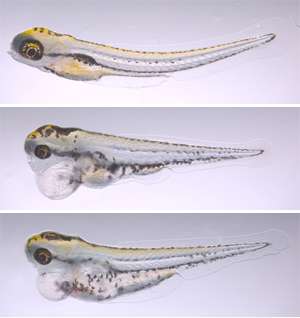The ELABELA hormone has been identified as an important apelin-receptor ligand in early heart development. Wild-type zebrafish embryos have normal cardiac development (top), while embryos lacking the apelin receptor (center) develop similar cardiac deformities to embryos lacking ELABELA (bottom). Credit: Elsevier
The binding of hormones to their receptors plays a key role in the development of many organs of the body. The apelin receptor is expressed in the developing embryo, coming online many hours prior to its presently known ligand, apelin. Organisms that lack apelin have less severe developmental defects than those lacking the receptor, leading scientists to believe that there is an alternative ligand for the apelin receptor that is expressed during the very early stages of development.
Now, Bruno Reversade and colleagues at the A*STAR Institute of Medical Biology and the A*STAR Institute of Molecular and Cell Biology in Singapore have identified the hormone ELABELA as an apelin-receptor ligand that is present at the earliest stages of development. The team's findings suggest that ELABELA plays a key role in the maturation of the endoderm and the creation of the heart1.
Early embryonic development is characterized by the development of three germ layers: the ectoderm, which forms skin and nervous tissue; the mesoderm, which forms the cardiovascular system; and the endoderm, which forms the inside of the gastrointestinal tract.
When the researchers generated zebrafish embryos lacking ELABELA expression, they found reduced levels of early endodermal markers in the early stage embryos. If they allowed the embryos to grow to later developmental stages, Reversade and colleagues found that the zebrafish hearts either did not develop or were highly abnormal. These findings suggest that ELABELA is required for the maturation of endodermal cells that drive the development of nearby mesodermal cells, which in turn go on to form the heart.
As the abnormal heart phenotype in ELABELA-deficient zebrafish embryos was similar to that of apelin-receptor-deficient embryos, the researchers decided to investigate if ELABELA acts by binding to the apelin receptor (see image).
They discovered that ELABELA and the apelin receptor are expressed at the same time and similar location in the early embryo. Expressing the apelin receptor in cell lines that did not normally express it allowed binding of ELABELA to the receptor at the cell surface, says Reversade. "These results suggest that ELABELA is the earliest ligand to bind to the apelin receptor through the role it plays in driving the primary stages of the development of the embryo."
ELABELA's importance to heart formation could also apply to the development of other organ systems. "ELABELA is expressed in kidneys and prostate in humans, but its role there remains unknown for now," notes Reversade.
More information: Chng, S. C., Ho, L., Tian, J. & Reversade, B. "ELABELA: A hormone essential for heart development signals via the apelin receptor." Developmental Cell 27, 672–680 (2013). dx.doi.org/10.1016/j.devcel.2013.11.002
Journal information: Developmental Cell






















